Don't wanna be here? Send us removal request.
Text
Lovely!
Finding Forgiveness (or, Text Barrages and Apology Dances)
Mini Meta-Musing #8
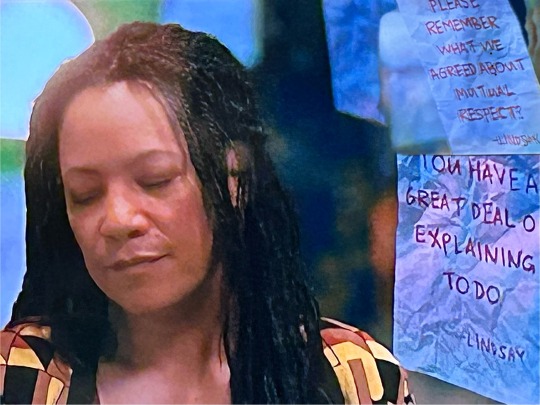
Forgiveness after a disagreement or an argument is such a simple yet complicated thing. In even the closest, most intimate relationships, it requires a great deal of trust and love. The person who caused the hurt must surrender some of their pride for the sake the loved one. They must also trust that it is safe to do so. The person who was hurt must be willing to let go of their anger or resentment, and open themselves up to the relationship again.
In the first episode of Season 2 of Good Omens, we are presented with two relationships in conflict. One uses words and words and more words... but there is no listening, no trust. The other settles the conflict with very few words at all. With a dance, in fact. Yet the trust and love there is deep and obvious.

The first is Nina and her partner Lindsay. Lindsay has assumed that Nina broke her trust by not calling when she was locked in the coffee shop with her phone out. Sure, the situation sounds a bit implausible... but Lindsay sends a barrage of accusatory texts before she knows any of the facts. As the days go by, we learn that not only is Lindsay controlling, but she also has no faith in her partner. She dumps words and accusations and guilt trips, never believing or listening or trusting, until finally breaking up with Nina in a resentment-filled text message.
After seeing that first deluge of text messages when Crowley restores power to the coffee shop, we are immediately shown a far different way to resolve conflict. The next scene is Crowley's melodramatic return to the bookshop. Aziraphale and Crowley have a lasting, deeply rooted relationship. Although some argue that they don't communicate enough, especially in this resolution, I propose that they have found a lovely and mature way to resolve serious conflicts.

Everytime I watch this scene, and see how intensely difficult it is for Crowley to accept doing this, I'm actually a little in awe. Crowley HATES DOING THIS DANCE!!! But as much as he hates humbling himself like this, he Loves Aziraphale MORE. It is far more important to him to fix their conflict quickly, be back on good terms, and help his Angel solve this Gabriel problem. Although his face looks fierce and his tone is irritated, his eyes never leave Azi's. I think they look a bit imploring. The apology is in his golden eyes.

" 'Kay?" is not just, "Are we okay now?" It's also a trust, a gift. "You understand how much I care about you, right? I really do accept how stubborn and thoughtless I was earlier, and you see that I'm very sorry, even though it's hard for me to say the words, yeh?"

Aziraphale is of course, deep down, just a bit of a bastard, so he does take a bit of a comeuppance in his "Very nice." Many of us read a bit more in that look... Crowley looks very elegant in that deep bow! Nonetheless, Azi is happy to be reconnected with his demon, and he eagerly engages with Crowley's brainstorming about their "tiny miracle."
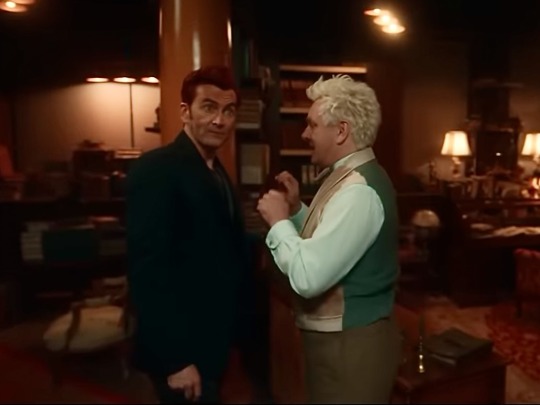
They don't need to verbally process what the fight was about. They've had this fight before, in varying contexts, and they'll surely have it again. But they're working on it, each of them. They know each other's faults, and they love and forgive each other anyway.
I love these moments (in the above photo) after Jimbriel toddles down the stairs. Crowley has just scolded Jimbriel to stay inside. Meanwhile, behind him, Aziraphale steps in closer with an idea. Without even looking back, Crowley steps backwards into that familiar spot where he will be perfectly paired and facing his angel once he turns towards him. Like magnets. Like a couple who is completely synchronized, as long as they are open and trusting each other.

And the familiar excited exchange of ideas begins again!
Oh yes indeed... This is definitely An Old Married Couple (I wrote a meta on it!). They know how to communicate, how to trust each other, and how to forgive. At least as well as many of us do...!
And, although we don't really NEED to see it here, I'm including a gif of Crowley's Apology Dance. It's beautiful, it's graceful... Aw, heck, we all just LIKE to see it again!
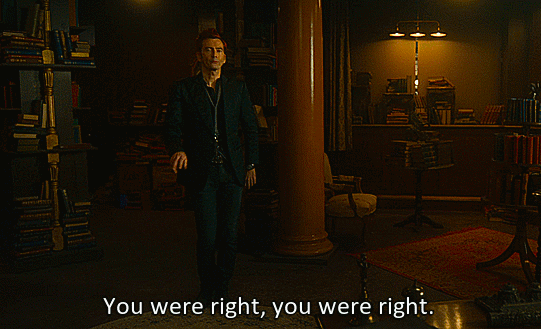
83 notes
·
View notes
Text
Good Omens S1 Parallels - 1/?
Saturday Morning Funtime is a particularly interesting episode for me, because it suggests something about the structure of parallels Season One. Also, it's easier to start with a single episode than trying to cover the whole show at once. I'm going to show you six different scenes from Saturday Morning Funtime and how they link together.
Let's start with the pun pointed out by Danny Motta in his video (link here to relevant timestamp if you haven't seen it). Danny made the link between this scene near the start of E4, where Aziraphale gets exercise:

And this scene at the end, where Aziraphale was exorcised (according to Shadwell, at least):

Cool, seems like a funny pun. But there's no way to know it was intentional right? Well, I think I can argue it was. Let's look at another scene.
We have this scene where Hastur destroys 3 Erics on the plains of Megiddo. Since each demon has a corresponding animal, I'm going to go ahead and place bets on the Eric's being rabbits, and Hastur destroys 2/3 of them.
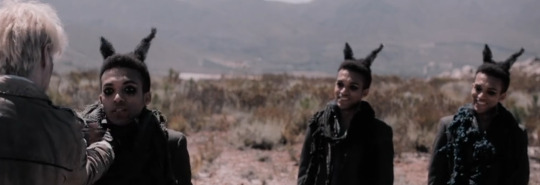
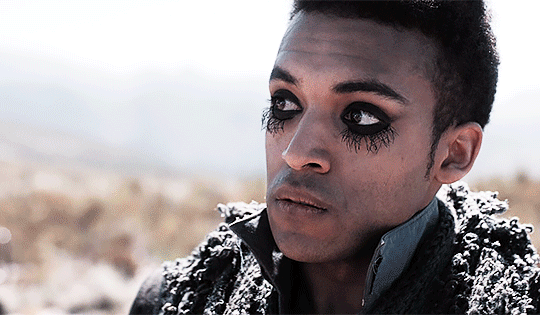
And then later we have this scene where Hastur again destroys 2/3 rabbits, but this time they're cartoon bunnies - the first one he beheads like a costume, the second he rips out it's throat.
youtube
Ok, but again, why am I linking these two scenes? No deep character insights, or thematic elements are being displayed here... Except that's a key reason I'm pointing them out - they're seemingly pretty pointless, so why bother to make them? Well, maybe the sum is bigger than the parts. One more example and then I'll show you how this comes together.
Here's a scene which I think is pretty good foreshadowing of something that will happen later in the episode - Hastur and Ligur talking about the dripping pipes down in Hell. Hastur has a little bucket he's collecting water in, which he uses in a toast:

And later, we have this particularly gruesome scene of Ligur becoming toast at the hands of a bucket full of (holy)water:
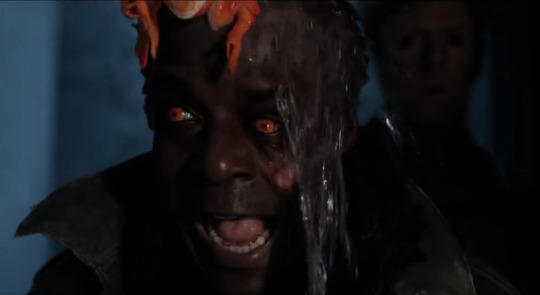
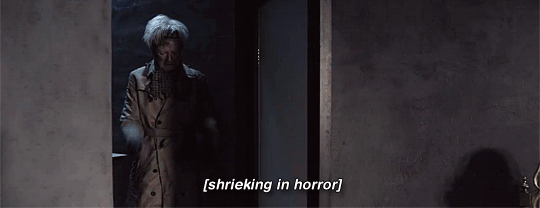
Ok, so six scenes, three sets of parallels... now's where the magic happens... I take E4 as a whole... loop it over on itself like a piece of trick rope from Goldstein's magic shop and....
Tada! Here's the episode laid out in 2 minute increments.

Some pretty interesting places to have parallels, no? That two minute block at the start is a lead in before the opening credits, so the Exercise and Exorcism scenes are coming directly before and directly after the open and close sequence (shown above in blue).
I'd be lying if I said it didn't remind me of the overall chiastic structure that some people have worked on, such as this one by @drconstellation, just on a smaller scale.
It's also interesting to note that each of these parallel pairs relates to someone getting discorporated - Eric, Ligur and then Aziraphale.
What's the point?
So, I promised that I would share a little on why this might be important. In my opinion? It appears like there is some detailed structure to Good Omens, at least in S1.
It should also be noted that these scenes were added only for the show in order to produce this effect - Aziraphale exercising with Gabriel, Hastur and Ligur talking about the pipes, the three cartoon rabbits in the theatre - they were all newly created for the show.
Why go to the bother of creating these little parallel moments at corresponding points along a mirrored structure? Especially when these don't necessarily have ramifications for characters or plot? Is it just good story telling or is it something more? These are all questions worth asking in my opinion. I think it relates to how this show treats words and language in a very Pratchetty fashion. The whole show is a dedication to Terry, after all.
Of course, if things were so simple, I think we would have figured it all out long ago. Parallels, puns, wordplay... they're all quite slippery things. There are things I would consider to be parallels which don't line up with this same structure. For example, the scene from earlier with Gabriel and Aziraphale exercising? The "lose the gut" gut-punch foreshadows this other gut punch scene in E4 too:


Despite examples to the contrary, the presence of parallels and wordplay that do line up along a mirrored structure makes me want to explore this further. If you're also interested in this and want to collaborate, please let me know.
This will be a continuing series, as and when time allows, because parallels seem to be absolutely everywhere. Future posts will look at parallels at different levels (within scenes, across episodes, and across seasons).
Let me know if you spot any others - I'd love to hear about them. They might be hidden in the visuals, wordplay, puns and more...
----------------------
With thanks to all the detectives for keeping me clue hunting @embracing-the-ineffable, @theastrophysicistnextdoor, @noneorother, @somehow-a-human, @komorezuki, @maufungi, @lookingatacupoftea, @havemyheartaziraphale, @251-dmr, @dunkthebiscuit, and @ghstptats <3
139 notes
·
View notes
Text
Very well written. Very nice.
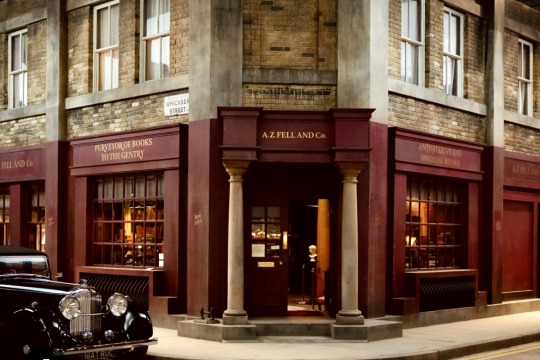
A Mini-Meta Musing (#1)
I'm always a bit surprised at how Aziraphale is underestimated in the fandom. (I know he's in everyone's bad books rn, but breathe deeply and hear me out!). I've seen a lot of debate about how much, in his relationship with Crowley over the years, Aziraphale is rigidly fixated on right/wrong, good/evil, and uses it to push Crowley away. Sometimes, however, these discussions forget to take into account how often Crowley was punished by Hell. And Aziraphale knows. Once he understood the constant risk of retribution the demon faced, Aziraphale's primary instinct and his self-appointed mission in the relationship became Protect Crowley. No matter what. Protect Crowley even when his friend is careless with his own safety. It's a huge factor in why he so often pushes Crowley away in later years, when they seem to be beyond all that. And I believe that it's also the real reason he built the bookshop. Aziraphale desperately hopes the bookshop can help keep Crowley safe.
It takes a very long time for Aziraphale to recognize how dangerous their relationship is for Crowley. In the early centuries, the angel is buying the Party Line -- if you made it through the Fall, you're holy and perfect. In Eden, and again in Job's cellar, he misses the demon's ironic humor and is very caught up in holier-than-thou thinking. That doesn't exactly enourage Crowley to confide his secret shame. Our devil-may-care demon desperately wants to look confident and dashing and independent, not fearful and bullied. Eventually, however, whether Crowley confided or Aziraphale guessed, our foolish Principality realizes the danger, and he grows up a lot. By 1601, at the Globe Theatre, he's more worried about the cruelty of Hell then Crowley is. Aziraphale at first *looks like* he's scorning Crowley's proposal in the arrangement, but he's actually trying, in his own way, to subtly "shush" Crowley's loud and daring carelessness. We know this because he then worriedly reminds the demon that, "if Hell finds out, they won't just be angry, they'll destroy you."
I propose that Crowley did actually get punished for his indiscretion in some way, sometime after that. When he shows up at the Bastille in 1793, sure, he's putting on fashion-model poses to impress the flirtatious angel, but he's also much less relaxed. There's a tension and moodiness in him that, chronologically, wasn't there in Essex or at the Globe. He's cynical again. But he doesn't tell the angel-- not that we know of, at least. Possibly because Aziraphale is feeling flirty and practically radiant that his handsome friend came to his rescue!
The meeting at St. James Park in 1862 was a defining moment for Aziraphale. Crowley had been literally sucked into a Hellhole, screaming, for saving Elspeth in 1827 Edinburgh. At the park in 1862, he's visibly stiff, barely even turning his head, carrying a cane, and incredibly subdued in all ways. There's no energized pacing, no hand gestures or leaning in. He hardly moves. His corporation was included in Hell's punishment, and he looks broken. Aziraphale couldn't possibly NOT see this. We know he was worried when Crowley was taken. We see this in present-day when he slightly bullies and borrows a phone immediately after remembering the events of 1827, just so he can check on Crowley! Back in 1862, he sees Crowley's despair and brokenness. Again, he handles it indirectly, and hurtfully. If he can't keep Crowley safe, he'll push him away, for his own good. Like an old tear-jerker classic movie where the little boy tearfully chases away his beloved dog so that the mean villain won't shoot it.
Aziraphale is an intensely emotional being who often seems overwhelmed by his own feelings, leading him to handle difficult situations badly sometimes. However, he's also incredibly loving. The former Guardian of the Eastern Gate is a protector by nature and by choice. He loves humanity, and risks his ethereal status repeatedly to protect them. He loves Crowley, his best friend, whether he feels safe to admit it aloud or not. He'll risk anything, including the friendship itself, to protect him.
For 1800 years, Heaven didn't have an embassy in London. If Aziraphale just wanted a physical building to store his treasured collection of books, he could have done that. Heaven is a corporate hierarchy with paperwork and red tape. There surely were requests and filings and complications in trying to get an official Embassy authorized! Possibly he could simply have obtained permission to own a simple shop as a "cover" to fit in with the humans (like eating sushi!). Instead, the bookshop is a Heavenly Embassy with miraculous protections. No one can enter unless first invited, not even angels. Only Crowley can freely come and go, at least until the chain of events at the end of Season 2. Prior to that, the bookshop is a safe place for them. Crowley is visibly more relaxed there. He and Aziraphale get along there, laugh and tease, and have their closest moments together. They are safe there, and Crowley can't be harmed within its walls.
This was Aziraphale's goal. He had too often felt the helplessness of witnessing how his relationship with Crowley put the demon at constant risk, even before 1827. From the time their friendship truly began at Job's home in Uz until Crowley was kidnapped by Hell in 1827, we never see Aziraphale try to discourage or end the relationship. Every interaction except Essex (537 A.D.) brought them closer together, and even Essex was quite collegial until Crowley first proposed "The Arrangement." Aziraphale hoped that creating the bookshop, with its protections, would help keep Crowley safe, or at least give him a temporary haven where he could relax and breathe more freely.
Imagine how powerless Aziraphale must have felt when 1827 slammed home the realization that he could never do enough to fully protect Crowley from Hell, or from Heaven for that matter. Yet, despite the danger, Crowley always seeks him out again, at continued risk. "Ducks have ears." Someone may always be listening. No wonder the angel unilaterally tried to end the friendship. Not a fair or emotionally healthy strategy, admittedly. But Not too difficult to understand.
Final note, my own fun little imagining about the shop name: A. Z. FELL & Co. I know that adding "and Company" was a common business technique to make one's appear large and prosperous. It wouldn't be unusual at the time for a single shop owner to use, particularly for a property as impressive as Aziraphale's. But it's my personal belief, be it fact or headcanon, that the angel was entirely thinking of his best friend when he added "and Company" to the shop name. Crowley has an open invitation, Crowley is his guest, his companion. Crowley is welcome company. A & C. A.Z. Fell & Co.
161 notes
·
View notes
Text
Okay so first I want to apologize for the poor image quality, and I believe I’ve seen a meta on this somewhere else before, but look at these people walking! In the scene Crowley is talking with the spy on the bench in the beginning of s2 ep1, these people with the briefcase enter from frame right and a second later from frame left. This is not the only other time something like this happens. In the scene where aziraphale is talking about driving “our car” to Edinburgh, there is the extra in the background (who looks like Jesus ha) who is crossing the street with a girl, and then they cross the street again from the same side.
Oh I love these “inconsistencies”, but what does it all mean?? Season 3 I need you

56 notes
·
View notes
Text
I don't read fanfic. But I would read more like this! Clever, short, and non-sexual.
Aziraphale’s phone rings. He answers, expecting it to be Crowley. But to his surprise, it’s a demon he’s never met.
“I’m Crowley’s replacement,” the demon says. “He’s not done anything impressive lately, and Downstairs doesn’t like how ineffective he is at keeping you in line. So now he’s shuffling paperwork and scooping up hellhound shit while I do his job for him.”
“Ah… I see,” Aziraphale says icily. “Well, I most assuredly do not look forward to working with you.”
The demon laughs. “Feeling’s mutual.”
Twenty-four hours later, the demon is very surprised to find himself discorporated in his sleep. He can’t explain what happened, he has absolutely no idea.
“Don’t let it happen again,” Beelzebub says, annoyed, and sends the demon back up.
After a mere three days, the demon ends up discorporated again.
A new replacement is sent up. This one lasts for a week and a day.
A third replacement is sent up. This one lasts for exactly four hours.
Three demons are sent up next time. Two manage to stay alive for at least five months. In that time, they botch four very important temptations, and the citizens of London inexplicably find their daily lives much improved in thousands of little ways. Traffic and pollution are nonexistent, injury and illness are miraculously avoided. Church attendance is up five hundred percent, and every politician and CEO is struck by the urge to donate as much money as possible to charity. There’s a general feeling of contentedness and goodwill in the air that wasn’t there before. It feels downright heavenly.
Suddenly, Beelzebub is having a very hard time finding anyone to take Crowley’s post. Bribes and threats make no difference. The rumors have spread and only grown more disturbing in the telling. Not one demon is willing to go up there and face the cold, calculated, merciless wrath of the angel known as Aziraphale.
Crowley absolutely loses it when someone gets around to telling him. “Y’know, I could’ve warned you,” he says gleefully. “Been working with him for thousands of years. I know exactly how much of a bastard he can be.”
After running the numbers and seeing how many souls they’ve lost to Heaven in the past year, Beelzebub gives up and concludes that trying to replace Crowley is a massive waste of resources Hell can’t afford.
After one year, Aziraphale receives another phone call. He answers, with bated breath, and nearly shouts for joy when he hears a familiar voice.
“Hi, angel. Lunch on me?”
62K notes
·
View notes
Text
In the end of S1E3 Adam is putting in bed and hearing voices like "you can fix it, do it, change it" and later he wants to fix the world and now I ve watched it and thinking about parallels with azi's "if i m in charge i can make a difference"

187 notes
·
View notes
Text

Michael Sheen's absolutely touching and moving moment on The Assembly where he waits patiently for Leo to ask a question has been nominated as TV moment of the year.
Please follow this link to vote!
As far as I can tell, you can vote multiple times a day, so go nuts (but not too nuts in case they think you're a bot and discount the vote).
And for anyone who didn't manage to catch that sweet moment, here is the clip below:
youtube
Let's get Michael recognised for the gorgeous, kind, empathetic human he is 🥹💙
Reblog for extra angel kisses 😇🩵
450 notes
·
View notes
Text
This is a hilarious idea.
imagine if Season 2 has been a comedy of errors this whole time.
Michael and Uriel asking Azirapahle for help, but so did Gabriel on one of his trios to see Beelzebub.
And Saraqael has been helping them along for her own uses, but all of them to get to the same outcome.
and none of them know about the others
just... sneaky angels being idiots because they don't know how to trust one another
thanks to @dunkthebiscuit and @embracing-the-ineffable for this hilarious idea
3 notes
·
View notes
Text
TIC 5 Opening Vid: We Didn't Start the Fire
youtube
Absolute perfection! <3 :))
300 notes
·
View notes
Text
Connecting Two of Michael's E1 Scenes
A few days ago I noticed that Michael's position sitting at the desk when she's talking to Beelzebub is basically identical to when she's sitting at the desk when the alarm goes off.
I've put the two together, taking out everything in-between, into one clip.
The one scene follows surprisingly neatly into the other. Yet they are at opposite ends of the episode.
It could be a coincidence, a style choice, for these two scenes to be so similar to each other.
Or, these two scenes are actually one scene, in-universe, but we've been shown it split apart.
But if it is one scene, it raises questions.
Because in-between these "two" scenes we are shown the following happening, in the following order:
Gabriel getting named Jim, discovering cocoa, the Terrible Thing, and bringing in the box.
Muriel finding the matchbox in heaven.
Aziraphale and Crowley chatting in the coffee shop.
The fight in the back room and Crowley storming off.
Nina and Maggie getting locked in the coffee shop.
Muriel and Saraqael showing the matchbox to Michael and Uriel.
Beelzebub taking Crowley to hell to talk about the missing Gabriel.
Crowley returning to the book shop.
The I Was Wrong dance.
The hiding miracle.
If the full scene took place early in the episode, this might imply that the alarm went off before the hiding miracle happened. And if the full scene took place late in the episode, that implies that Beez talked to Crowley in hell before getting the call from Michael.
I would love to hear your thoughts on this. Do you agree that these scenes go together? Does it make you question any other sequences of events? Would it make you question what triggered the alarm?
#good omens s2#gos2#archangel michael#good omens#good omens meta#good omens discontinuity#ineffable mystery#alarms in heaven#Crowley: You are out of order!#go meta
135 notes
·
View notes
Text
Excellent!
The Price of a Life: Death and Dying in Good Omens
In this meta I want to take a closer look at one of the prominent themes I’ve spotted running through Season 2 of Good Omens. While S2 has been billed as the gentle and romantic bridge towards S3, in a few ways it actually had darker tones than S1. If that’s your cup of tea - read on!

What is the value of a human life?
This is a question which has been pondered by philosophers far back into the reaches of history. More recently, economists have attempted to put a price on human life, which is then used when justifying the various societal costs associated with governing a population (i.e. healthcare, education). These two different schools of thought are sometimes at odds. Immanuel Kant proposed that humans have invaluable dignity, but not a price - being “not merely something to be used for the ends of others, or traded on the market”[1]. In opposition, value of life calculations, by definition, put a price on the value of an individual.
What side does Good Omens S1 take?
In Good Omens Season 1, one of the significant moral dilemmas, at least for Aziraphale and Crowley, was about whether or not to kill the antichrist.
I've never actually... killed anything. I don't think I could. Not even to save everything? One life... against the universe.
Following their failed attempts to influence Adam’s childhood development, once at the airfield, Aziraphale believes it to be a foregone conclusion that Adam should be killed - eliminate one to save the many. Of course, their attempts fail and Adam faces off against Death, the Four Horsepersons and Satan himself, eventually getting his own way. However, the moral question posed about killing Adam never reaches a definite conclusion.
With the flashback scenes that S1 added to the book, we are shown this same theme when Aziraphale and Crowley attend the crucifixion. The crucifixion is shown in agonising detail here, and gives us an empathetic look at the sacrifice of one life for, presumably, the overall good of humanity. (Although, what metaphysical impact Jesus’ death had in the Good Omens universe isn’t exactly clear). We see Aziraphale and Crowley stand idly by while the Great Plan is enacted.
Does S2 do things differently?
While Good Omens S1 dabbles lightly in the philosophical question about the value of life, Season 2 picks up this thread time and time again - sometimes attaching some numbers!
One of the key mysteries of present-day S2 is the mammoth miracle performed by Aziraphale and Crowley. Registering on the scales at 25 Lazari, this is 25 times the cost of human life in Heaven's accounting system. Presumably, one Lazari is the amount used when Jesus resurrected Lazarus of Bethany four days after his death. As we'll see, this attaching of numbers to human lives is then repeated throughout each of the minisodes.
Firstly we have the flashback sequence with Job and his children. Aziraphale makes the argument that just doubling the number of new children wouldn’t adequately compensate Job and Sitis for the loss of their existing children - since they “quite like the old ones”. The value of human life is not a simple accounting exercise and one life cannot be substituted for another, in the case of the people you love - they’re priceless.
We see this same idea demonstrated again throughout the Resurrectionist minisode. We first meet Elspeth MacKinnon when she is exhuming a body to sell, in order to buy her and her partner a slightly better life worth living. However, the surgeon Dalrymple is not above haggling over human remains. To him this is a business transaction, in which dead bodies are worth no more than five pounds a pop. To Dalrymple, the cost of saving future lives is that others should risk the grave gun gathering bodies which he may then dissect.
Aziraphale is first opposed to anyone being dug up, but then is won over by Dalrymple’s argument, at least until Wee Morag is killed and suddenly for sale. As Crowley says, echoing the Job minisode, “it’s a bit different when it’s someone you know”. In opposition to Dalrymple’s accounting exercises, and, indeed, the 90 guineas with which Aziraphale buys Elspeth's life, Crowley is offering an alternative view. A life is of higher value when it is someone we, personally, know and care for.
We also witness this theme during the 1941 flashback / Nazi-zombie minisode. The magic shop owner warns Aziraphale that he is about to take on a death-defying trick - one which people have died trying, no less! “Your life is worth a lot more than seven pounds five shillings,” argues the shopkeeper. Instead, it turns out that a customer’s life is worth about 27 pounds and five shillings, since he more than willingly accepts that offer - “on your head be it!”.
As human beings, the price we are willing to place on an individual life, how much we are willing to sacrifice for that person, is all dependent on how well we know them.
“He’s just an angel I know”
But it’s the knowing that makes all the difference.
“It’s a bit different when it’s someone you know”
So, for his life, what price are you willing to pay?


What if it was “one life... against the universe”?
Lastly, death is the price that all humans must pay, no matter what. As the Metatron asks at the end of S2 - “Does anyone ever ask for Death?”. But those are thoughts worthy of a future post.
Thank you to everyone at the @ineffable-detective-agency as always, but especially @lookingatacupoftea and @embracing-the-ineffable for their feedback on this post.
[1] Nussbaum, M., & Pellegrino, E. D. (2008). Human dignity and bioethics: essays commissioned by the President's Council on Bioethics. JAMA, 300, 2922.
140 notes
·
View notes
Text
How has no one called the yellow feather duster out yet?
How in the Freddy Mercury has no one yet pointed out that the yellow feather duster moment is a huge shoutout to one of the most Good Omens coded Queen songs of all time: I Want To Break Free.


I can't unsee it. This is now Gabriel's fight song. He's fallen in love for the first time and needs to break free. Just check out these lyrics if you've never heard it...
youtube
I want to break free I want to break free I want to break free from your lies You're so self-satisfied, I don't need you I've got to break free God knows, God knows I want to break free
I've fallen in love I've fallen in love for the first time And this time, I know it for real I've fallen in love, yeah God knows, God knows I've fallen in love
It's strange but it's true, yeah I can't get over the way you love me like you do But I have to be sure When I walk out that door Oh, how I want to be free, baby Oh, how I want to be free Oh, how I want to break free
But life still goes on I can't get used to living without, living without Living without you by my side I don't want to live alone, hey God knows, got to make it on my own
So baby can't you see I've got to break free I've got to break free I want to break free, yeah I want, I want, I want, I want to break free
With love, Your Ineffable Detective Agency
Special thanks to @lookingatacupoftea who's roof troubles directly led to this. Our other members include: @embracing-the-ineffable, @kimberleyjean, @theastrophysicistnextdoor, @maufungi, @somehow-a-human, @ghstptats, @havemyheartaziraphale, @dunkthebiscuit, and @251-dmr
1K notes
·
View notes
Text
Aziraphale doesn’t need to be saved. He never has. He gave away his flaming sword and lied to God's face. He tricked Heaven once again to save three kids. He claims to be soft, but he is anything but. He stood with his flaming sword facing Satan. He stood with a dumb candelabra facing a horde of demons to save his bookshop and protect humans. He is absolutely capable of getting out of any situation. But oh, how Crowley loves to save him.

4K notes
·
View notes
Text
What was that about Adam's gravestone again...?
I finally got my hands on a 4k copy of the opening credits of GO S2. So, before I write up the huge dissection post, let me just say something extremely fishy is going on in the graveyard portion.

Thanks to some help from my friends over at @ineffable-detective-agency, we've managed to manipulate the footage enough to read Adam's green gravestone, with some with suspicious results. (here's a closeup, and the transcription I was able to pull off the footage, click to enlarge).

here lies.... ADAM "I do not understand, surely your __________________ requires ________________________ of ___________." If your senses are tingling, that's because this phrase is actually pulled from Good Omens the novel, helpfully provided by @somehow-a-human's copy below:

They made is very hard to read indeed, but it does seem that despite Neil Gaiman's sneaky misdirections, this grave is in fact about Adam Young.

So this gravestone *is* about Adam Young, and yet we know that he's also fine. To reconcile the two, what if we took a lateral approach. After all, there are at least 2 meaning of the word "lies"....


When we see the words "Here lies" on a gravestone, we're given heaps of cultural and contextual information to infer that the first meaning of the word "lie" is meant. But if you're using language games and puns all over the place, who's to say that "Here lies..." doesn't mean something entirely more sinister.
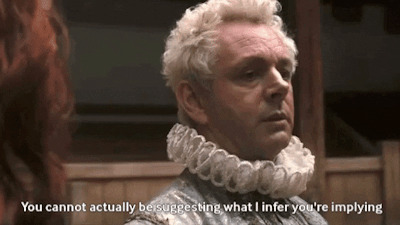
With love, Your Ineffable Detective Agency Our other active members include: @embracing-the-ineffable, @kimberleyjean, @theastrophysicistnextdoor, @maufungi, @somehow-a-human, @lookingatacupoftea, @havemyheartaziraphale, @dunkthebiscuit, and @251-dmr
146 notes
·
View notes
Text
The Ineffable Detective Agency Presents: What Happened in Before the Beginning?
Hello Good Omens clue hunters and detectives! I’m super excited to share what we’ve discovered in Before the Beginning. Read on if you want to see what no one else has spotted yet!

To put a long story short, something is “up” about Good Omens - Season 2 in particular. While the eagle-eyed have documented a number of odd things in Season 2 already (summarised here), I’ve never seen anyone call into question what was presented during the Before the Beginning scene. Let’s take a closer look shall we?
Remember this scroll to start the nebula? Well, guess what - it changes!
Here’s the first scroll we see on screen, I’m going to call this the “new” scroll. Note the straight edges and completely pristine look, like brand new paper:
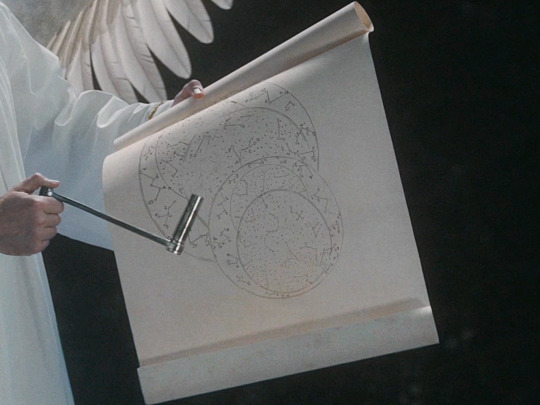
Then suddenly, here’s what it looks like as they start up the nebula:
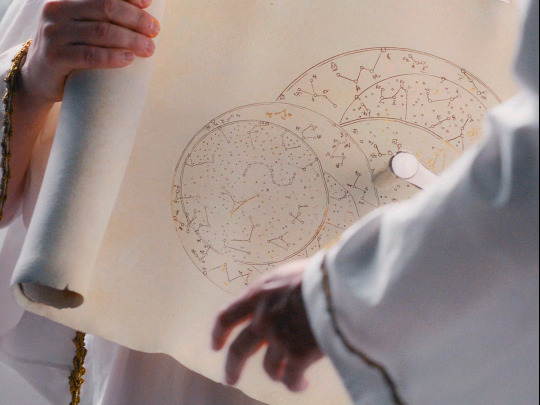
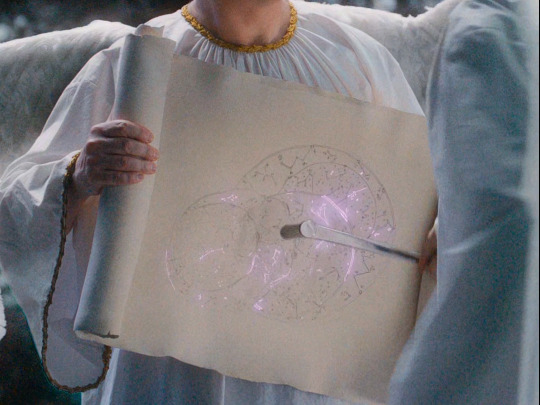
Whoa, that’s looking pretty old and ragged! It’s got rips, a bit of discolouration, several wavy bends running through it. That’s a significantly more worn scroll than we were just shown. Let’s show that in close up just to be sure:


Yup, that’s certainly not meant to be the same scroll!
During this scene, the old scroll is seen again during the close up of Aziraphale holding it. However, once Crowley instructs him to put it down, it’s the new scroll again. (And then at this point it disappears into hammerspace like in a cartoon, or drifts off into space, never to be seen again).
So... there's TWO scrolls?
Well, yes, but also, no. If you're wondering, “Are they both real scrolls? Are you telling me they had two on set?” the short answer is no, this was done with VFX. To explain why we know this, I’m going to hand over to our resident Art Director, @noneorother:
Hi all, @noneorother here. Sure. So it's mostly to do with the shadow inside the scroll curls and under the right hand side curl. You can see when it's the real scroll that the shadows are all orange or brown, because of sub-surface scattering:
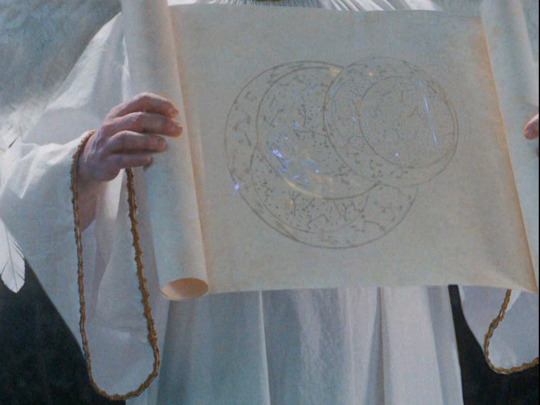
It happens when light partially passes through a thin porous object like skin or paper. So when the scroll is new, it's real. Where they've added "scroll is old now" VFX on top of the shots, it's very well tracked, but there's no more sub-surface scattering because it's VFX, not filmed. So the shadows are now base-black inside the curl and to the right hand side of the image. This is the VFX scroll here:
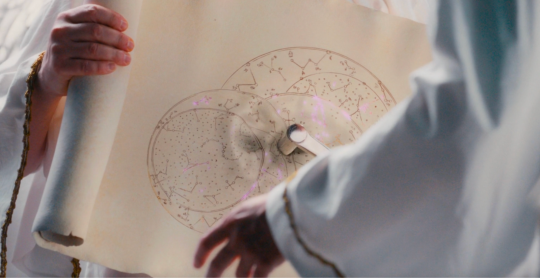
They already perfectly tracked the astronomy animation into the center of the scroll, so they had all that tracking info just sitting around. It wouldn't have been very expensive to add the "old scroll" the way they did it (the cheap and dirty way).
Thanks @noneorother! So there we have it folks, the Good Omens team have intentionally designed some shots with the old-looking VFX scroll and some without. They had the assets created for the old scroll and the tracking to place it correctly, so how could they possibly make the “mistake” of adding it sometimes but not others? This wasn’t a budget thing. If it were budget related, they wouldn’t have created the old scroll VFX in the first place.
Personally, I think this discontinuity was to tell us, the dedicated rewatchers, that what we initially saw in S2 was not the whole story. There is something else at play during S2. Something that, depending on what we find, may make S3 even more enjoyable.
So, why do this? Is this scene being conveyed from different perspectives? Are we viewing different characters’ memories of the same event? If so, why would that be important? Is someone tampering with past events? Did “Before the Beginning” happen multiple times and we’ve seen a spliced together version? What do you think?
One More Question...
The other question worth asking here (which Aziraphale helpfully asks for us) is “which way up” does the scroll go? Look closely at the central rings.
Is it the top version (small rings to the right)?

Or the lower version (small rings to the left)?

... and what happens if you create a nebula upside down, I wonder? Here I’m reminded of the Nightingale Sang in Berkeley Square lyrics:
The moon that lingered over London Town Poor puzzled moon, he wore a frown How could he know we two were so in love The whole darn world seemed upside down
In a season where something is going "Down in the Up", and the answer to Gabriel’s mystery is achieved by turning the delivery box upside down, this is yet another up-down reversal we can add to the list!
...................................................................................
If you’ve been following our Good Omens posts up until now, you’ll be aware that this is not the only time scenes have been inconsistent or discontinuous. If this is new to you, please check out my summary post on Season 2 discontinuity here. For more of our posts, plus a collection of Clues and metas from all over the fandom, see here.
However, there is still more to come, so watch out for future updates. If you’re not currently puzzling over Good Omens and would like to join in, please do! We’d love to hear what you find - you can use the tag #ineffable mystery.
Thank you as always to all the lovely people at @ineffable-detective-agency, with special thanks to @noneorother and also @embracing-the-ineffable.
210 notes
·
View notes
Text
Someone thinks Maggie and Nina are interchangeable.
Over at the Ineffable Detective Agency we've been cleaning house, trying to determine what we haven't posted yet. This quick one has been on the back burner for months! In the beginning of Episode 6, watch the blocking of the 56 second scene where Aziraphale and Jim deposit candles around the magic circle. Two weird things are happening at once here, see if you can spot them:
Here are paused images of the same angle, in case you missed it :


As well as the candles all going down unlit and suddenly being lit when Shax enters the doorway, Maggie and Nina decided to teleport to each other's spaces in the blocking of the shot.
Needless to say, this is a big no-no in filmmaking and blocking in general. You want to know where people are moving in a shot sequence, otherwise your brain loses sense of relative position in the scene. There are co-ordinators and script supervisors who spend their days on sets like Good Omens making sure this never happens. You have to actively try to make a blocking mistake this bad.
So why are Nina and Maggie so interchangeable in this scene that it doesn't matter which one is occupying the left or right of screen? Or is it the switch that's important... With love, Your whole ineffable detective team @embracing-the-ineffable, @kimberleyjean, @theastrophysicistnextdoor, @ghstptats, @somehow-a-human, @lookingatacupoftea, @dunkthebiscuit @havemyheartaziraphale, @komorezuki, @251-dmr, @maufungi
154 notes
·
View notes
